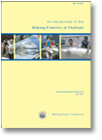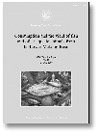Mekong News - Archive
January - March 2008
Issue 2008/1
In this issue:
- Mekong stakeholders discuss basin planning
- Council meeting records good progress, partnerships
- Monitoring delivers data to decision makers
- Near real time maps help flood forecasting
- New MRCS CEO
- Germany aids flood disaster management and planning
- Offices put focus on watersheds
- Thiess Riverprize nominations closing
- Information Products
- Upcoming events
Mekong stakeholders discuss basin planning

Basin planning involves trying to
achieve balance in the uses of Mekong Basin
resources.
A wide range of interested groups converged on the Lao capital, Vientiane, on 12-13 March to discuss planning processes for the development of the Lower Mekong Basin at a Stakeholder Forum held by the MRC Basin Development Plan.
The forum, attended by representatives of the Member State governments and their development partners, academics, and members of civil society organisations and the public, offered a chance for various parts of society to exchange views on what constitutes sustainable development in the Mekong River Basin, and on the multiple uses of water and related resources.
According to Mr Chantavong Saignasith, Member of the MRC Joint Committee and Director General of the Lao National Mekong Committee Secretariat, a participatory process and the forging of strong partnerships with the basin's stakeholders are essential to developing the economic potential of the Mekong River system in a sustainable manner.
The Basin Development Plan is being designed to take on board different views so that the MRC can help its Member States develop a shared vision to move forward and take coherent actions for the development of the basin in a transparent manner.
One of the major themes expressed by participants at the forum was that economic growth will lead to significant changes in the annual flows of rivers in the Mekong Basin, and the use of their water, complicating the task of development planning, and making it vital that decision-making processes become wider and more inclusive.
A traditional view of the Mekong is that its power has not been harnessed - that because of the lack of storage dams, a lot of water is not utilised but is left to flow into the sea unused. This means there is enormous potential for hydropower, agriculture and other activities if wet season flows can be harnessed. The conventional wisdom applied by economic planners is that the excess water that causes flooding in the rainy season can be stored to generate hydro-electricity and irrigate crops during the dry season.
However, there is increasing acknowledgement that if the natural flood pulse of the Mekong and its tributary rivers is restricted, and dry season flows increase to far above their natural levels, then the reproductive cycles of fish and traditional farming systems could be disturbed. Such a scenario could lead to environmental and food production problems, particularly among the poorest people of the region.

Representatives of many parts of society
came to add their voices to the Basin
Planning Process.
The meeting did not seek to produce any agreement on such issues, but rather gave a platform for decision-makers and researchers from governmental, international, non-governmental, and private organisations to share information and express views on basin development. Some participants called on the MRC to use the second phase of the BDP to bring more groups and views into the planning process. Officials from the Member States of the MRC - Cambodia, the Lao PDR, Thailand and Viet Nam - stressed the need to cooperate to use the rich resources of the Mekong to improve living conditions across the basin.
MRC staff pointed out that there are no magic solutions to the challenges facing basin decision makers. While research, monitoring and scientific modelling can provide much information on current situations, and on the possible effects of large individual projects such as storage dams, the cumulative effects of rapid development will affect rivers and the communities around them in ways that cannot be exactly determined. The BDP will help meet this gap, provided that information is provided by all countries and sectors of society.
Several participants expressed their appreciation of this chance to become involved in the process, and emphasised that now is the time to accelerate this involvement, at a time when decisions are taken that will affect water and water use in the Lower Mekong Basin.
Council meeting records good progress, partnerships

A good end to a good meeting as the
minutes are signed in Siem Reap.
The 14th meeting of the MRC Council was held in Siem Reap in November 2007.
H.E. Mr Lim Kean Hor, MRC Council Chairman for 2007-2008, Minister of Water Resources and Meteorology, Chairman of the Cambodia National Mekong Committee and Member of the MRC Council for Cambodia, told the meeting that support from the development partners had been strong and consistent over the past year.
It was reported that in 2007 the MRC signed agreements worth over US$20 million to fund its programme work and this had enabled the MRC to develop a proposal for a new hydropower programme; to fully develop the Information and Knowledge Management Programme (IKMP); to build capacity in the MRCS and NMCs; and to continue work in basin planning, fisheries and the environment.
In 2007 the MRC was also able to start phase two of its Basin Development Plan Programme (BDP). The BDP and IKMP, embody the central business of the MRC - development planning and knowledge.
Phase 2 of the BDP will see the preparation of a rolling Integrated Water Resources Management-based Basin Development Plan, a portfolio of programmes and projects identified and shortlisted under the BDP Planning Cycle, better assessment tools and an improved knowledge base and enhanced capacity for planning and mediation.
In 2008 the MRC will also commence the second phase of its Junior Riparian Professional capacity building scheme, which will help promote integrated water resources management abilities among young professionals and academics in the basin.
H.E. Mr Lim Kean Hor added that the MRC had also further consolidated its relationship with the World Bank and the Asian Development Bank and was working closely with them in their regional initiatives. The meeting heard progress reports from the MRC programmes, progress on the 2006-2010 Strategic Plan and approved MRC's operating budget for 2008.
The meeting also discussed the input from its development partners following the annual Donor Consultative Group (DCG) meeting held the previous day at the same venue. The DCG issued a statement calling for faster implementation of the Organisational Review recommendations and increased financial contributions to the MRC budget by the Member States.
The Group also called on the MRC to "show leadership in major development initiatives", including hydropower, to increase stakeholder consultation, and to improve monitoring and evaluation (M&E) procedures. The Chairman of the MRC Joint Committee responded by outlining progress in the Hydropower Programme set up, and requesting increased capacity building to enable accelerated riparianisation of staff positions. He also pointed out that a new M&E system was already in the pipeline. Full details of the DCG statement and the MRC response are available at www. mrcmekong.org/group-statements.htm.
Earlier in the same week, the MRC held talks with representatives from China and Myanmar at its 12th Dialogue Meeting. Discussion included plans for water resource development on the Lancang/Mekong River and progress of the improvements to navigation project.
There was also discussion on possible future areas of co-operation including increased co-operation on the provision of hydrological data in the flood season and sharing of knowledge on the development of flood forecasting systems.
Other fields included potential for the expansion of co-operation water quality monitoring including joint projects; exchange of expertise in mathematical modelling systems; and the possibility of the introduction of an academic and private sector exchange programme between China, Myanmar and the MRC Member States.
Monitoring delivers data to decision makers
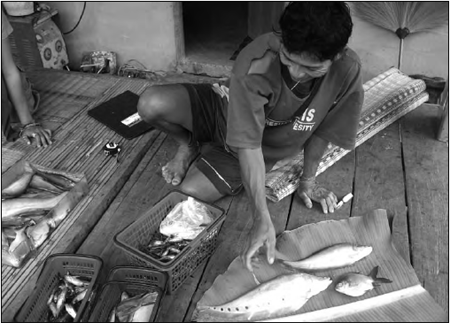
Local fishers play a vital part in
the monitoring of species in the Mekong
at all the montioring sites throughout the basin
AS development in the basin increases, it is vital for government decision makers to have sufficient data at hand to make sound decisions on trade-offs, costs and benefits of any interventions.
In order to help achieve this, the Fisheries Ecology, Valuation and Mitigation (FEVM) component of the MRC Fisheries Programme is engaging in some exciting research on several areas of the fishery which will allow local people to have an increased capacity to manage and plan this vital resource.
The FEVM component has been monitoring the status and trends of fisheries resources, improving knowledge of the socio-economic value of fisheries resources and their ecology as well as developing predictive models for basin planning purposes.
Research work has been carried out in conjunction with local fishers who joined forces with the programme to monitor abundance and diversity of fish in their regions. The programme has already published a comprehensive consumption study in 2007 and this will be further enhanced in the future.
Local fishers began monitoring the abundance and diversity of fish in June 2007 at 23 sites in four habitats (mainstream, tributary, flood plain and estuary). At each site fishers recorded their daily catch by species, how often they fished and the gear used. Special forms and identification charts were designed and produced in local languages to make the task easier for the survey team. As their information is received it is fed into a new daily catch monitoring database.
The component is also monitoring several types of important fish trapping and netting systems in the Lower Mekong Basin, such as the Li trap fishery in Lao PDR (which traps fish as they migrate upstream) and the dai fishery in Cambodia which hauls in tonnes of fish as they leave the Great Lake in the receding flood. Both these studies are generating data on amounts and types of fish caught and the times of year they are caught. Work is also being conducted to improve understanding of how fish stocks respond to water availability and flooding patterns.
Teams are also monitoring larvae abundance over a fixed sampling period. As larvae often drift for kilometers this will shed light on numbers and importance of species in certain areas at certain times as well as helping to identify and map critical fish habitats.
All these data are being consolidated and shared between Member States and with the assistance of fisheries models it will allow scientists to predict the response of fish resources and critical habitat to changes in hydrology and basin development.
This knowledge can, in turn, allow for mitigation measures to be evaluated and assist regional and national planners in their decision making on development in the basin.
For more information contact Dr Ashley Halls, halls@mrcmekong.org
Near real time maps help flood forecasting
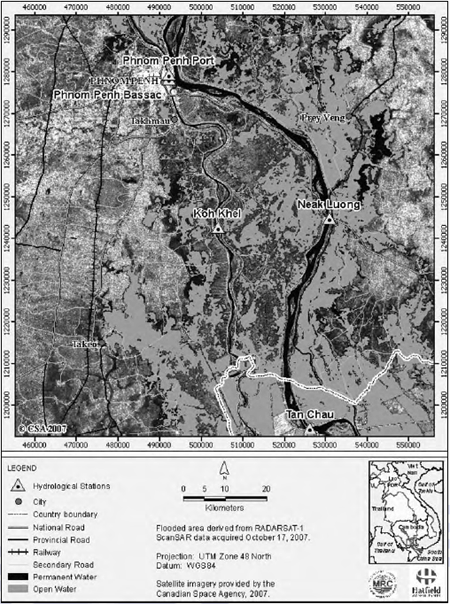
An example flood map derived from
a RADARSAT-1 ScanSAR image, acquired
October 17, 2007 from the MRC website.
The Mekong River Commission has expanded its use of the RADARSAT-1 satellite to accurately map the extent of the annual floods, and supplement and complement data from river gauges and flood models. RADARSAT-1 is particularly useful for flood mapping because of its ability to see through clouds and depict sensitivity to flooding.
In 2007, the regular annual flood mapping took a step forward through the implementation of a near real-time flood mapping service implemented in partnership with the Canadian Space Agency and Hatfield Consultants (Canada).
Every five to seven days, this service provides a set of flood map products to the MRC, which are made available to users of the MRC Flood Forecast web portal (http://ffw.mrcmekong.org) within 24 hours of acquisition. Between June and December 2007, a total of 84 individual flood maps were delivered on 24 individual dates.
The weekly acquisition of radar imagery over the Lower Mekong Basin since July has provided an unprecedented amount of information on the pattern of flooding. October is usually the month when the monsoon floods in Southeast Asia start to recede. In 2007, however, October appeared to be the month of peak flooding in the lower Mekong floodplain and the delta area.
A flood change map can be used in conjunction with actual river gauge measurements from the MRC's flood forecasting and river monitoring website, http://ffw.mrcmekong.org. The flood gauge information confirms the interpretation of the RADARSAT-1 imagery, and the flood change product. The overall trend of this year's flood season suggests that 2007 may be considered as a 'normal' flood year in the lower Mekong basin.
Flood mapping using RADARSAT-1 helps Component 1 of the FMMP to support the Annual Mekong Flood Reports. Near real-time flood map products are also potentially a valuable part of future emergency flood response and mitigation.
New MRCS CEO
Jeremy Bird, a specialist in water resources management from the UK, has been appointed new Chief Executive Officer for the MRC Secretariat, based in Vientiane. A Chartered Engineer with qualifications in water law and policy, Mr Bird has over 25 years of international experience in the water sector.
Already familiar with the Lower Mekong Basin region, Mr Bird will bring to the MRC sound knowledge on utilisation of international waters, and a good understanding of development issues related to hydropower projects, environmental and social assessment, flood management, and irrigation.
Mr Bird has expressed his excitement at working with staff in Phnom Penh and Vientiane. He is looking forward to returning to the Mekong region, to building on the team spirit in the Secretariat, and to improving cooperation with National Mekong Committees and line agencies.
Germany aids flood disaster management and planning
On 22 November 2007 the Government of Germany and the Mekong River Commission signed a new agreement worth €3 million to fund the MRC's Flood Management and Mitigation Programme (FMMP).
The agreement was signed at the MRC Secretariat on 21st November 2007 by Mr Hanspeter Schwaer for the Federal Ministry of Economic Cooperation and Development and Mr Do Manh Hung, Officer-in-Charge of the MRCS. The new funds will support two FMMP components.
Component 4 aims to strengthen capacities for disaster management boost capacity in flood disaster management. This component is working to ensure the improvement of existing emergency management systems in riparian countries to deal with the Mekong Floods more effectively, through capacity building, knowledge sharing and public awareness campaigns at the provincial, district and community levels.
Component 5 aims to improve land management techniques through the use of flood probability maps and will address the pressing issues of flood probability assessment techniques, improved land-use planning methods and damage-reducing land management policies in order to achieve sustainable natural resource management in the basin.
The aim of this technical cooperation is to improve the flood control policies of the MRC Member States along the lower Mekong as regards disaster management and land policy.
The projects will be implemented by the German development agency, GTZ.
Offices put focus on watersheds
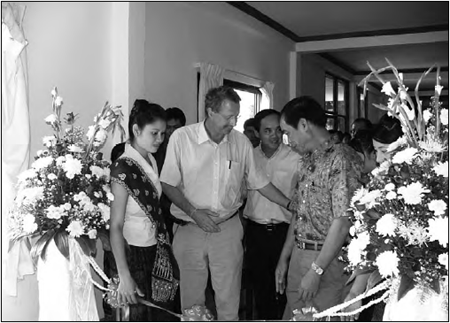
The opening of learning and training
offices will help communities across the
basin project the inherent value of their watersheds
The MRC-GTZ Watershed Management Project will open seven Watershed Management Learning and Training Offices in the MRC Member States of Cambodia, the Lao PDR, Thailand and Viet Nam over 2008.
The first such office was opened in November 2007 in Ban Phialat, in the Lao district of Sangthong and is one of two planned for the Lao PDR.
The new Watershed Management Learning and Training Offices are designed to give local people the opportunity to raise awareness of the importance of sustainable natural resources in relation to water and water resources management, and watershed issues. The offices will provide communities with useful and understandable information on the functions and services of the watershed in their area, as well as on its problems and challenges.
Visitors will be able to view the principles, impacts, methods and tools which can be used to achieve sustainable watershed management, and can also take special training sessions designed to fulfill different information needs.
The offices can act as communication platforms for news, knowledge, and all kind of data on sustainable watershed management and it is hoped that they will become gathering points for all concerned with watershed management, eventually developing into more sophisticated watershed management centres. Local people, extension workers, and planners can thus become involved in making more detailed information available for professional needs.
As the information provided is expected to be first hand and specifically from the watershed, the data and information collected and stored in Watershed Management Learning and Training Offices can also be used for planning local strategies for flood and/or drought mitigation, climate change adaptation and related issues.
Tourists looking for specific information on stream and watershed ecology will be welcome at the offices and any resulting increase in ecotourism will also benefit the hosting villages.
All Watershed Management Learning and Training Offices and Centres will be equipped with a set of useful maps and satellite images of the area (administration, topography, population, land and forest cover, drainage and water catchments etc.). Furthermore, equipment will be provided for communication and training. A water quality test tool kit will be available to enable testing and monitoring of the water quality of rivers and streams.
For further information: Dr. Ulrich Hoesle, hoesle@mrcmekong.org
Thiess Riverprize nominations closing
Nominations for the annual Thiess Riverprizes close at the end of March. Internationally renowned for recognising and rewarding best practice in the restoration and management of river systems around the world, the Thiess Riverprize is the most coveted award of river basin and watershed management groups.
First established in 1999, the Thiess Riverprize offers the highest monetary award of river management prizes (500,000 Australian dollars), and global recognition at the annual International Riversymposium in September. There are two awards, the International Thiess Riverprize and the Australian National Thiess Riverprize. 2008 marks the tenth anniversary of the awards, the international version of which was won by the MRC in 2002.
International judging panel Chair, Professor Paul Greenfield, says the Thiess Riverprize Awards offer organisations committed to water sustainability a unique opportunity to take action on river rescue ideas. "The prize recognises best practice in the restoration and preservation of waterways worldwide", says Prof Greenfield. "Like many countries, Australia is in the grip of a water crisis and now more than ever, it is encouraging to see projects both here and overseas combining science, public policy and community action to address river health".
To celebrate the tenth anniversary the organisers of the prize, the International Riverfoundation, are this year publishing a new Riverprize book featuring the international organisations which have won the award over the past ten years. Preparations for this publication have included an extensive interview with Chairman of the MRC Joint Committee for 2007-2008, Mr Nguyen Hong Toan.
Information Products
Lao and Thai Fisheries Films
These films about the The Lao film Fisheries of September 2007 $5.00 (Plus postage) |
Proceedings of the 5thAnnual Mekong Flood Forum
This CD-ROM contains the proceedings of the 5th Annual Mekong Flood Forum Flood Forum, 'Improving Inputs Towards Medium Term Flood Forecasting and Warning in the Mekong Basin', held in Ho Chi Minh City, Viet Nam on 17-18 May 2007. The CD includes text of presentations and photographs. July 2007.US$3.00 (plus postage) |
|
An Introduction to the Mekong Fisheries of Thailand.
This report on the fisheries of Thailand is designed for the non technical reader and features a description of the Thai fishery and its importance to people at all levels of society in Thailand. Featuring many colour photos and illustrations.This report is available in English and Thai. September 2007 US$10.00 (plus postage) |
Consumption Study
The full title of this |
|
For access to the latest reports and research on development issues, visit www.mrcmekong.org
|
||
| How to order | Contact | |
| All products can be ordered from the MRC Secretariat's Documentation Centre. Postage costs apply. Mekong region government agencies may write to the MRC to obtain free copies. Check the MRC website for a full list of products. Credit card sales are also available through the website, www.mrcmekong.org/publications/. All products are also available as free downloads from the MRC website. | Documentation Centre Mekong River Commission Secretariat
P.O. Box 6101, 184 Fa Ngoum Road, Unit 18, Ban Sithane Neua,
Sikhottabong District, Vientiane 01000, Lao PDR Phone: (856 21) 263 263 ext: 1122 Fax: (856 21) 263 264 Email: doc.centre[at]mrcmekong.org (replace [at] with @) Website: www.mrcmekong.org |
|
Mekong Day and Official Opening of the
MRC Regional
Flood Management and Mitigation Centre Building
5 April, Phnom Penh
6th Annual Mekong Flood Forum,
27-28 May Phnom Penh, Cambodia
amff6@mrcmekong.org, or amff6.mrc@gmail.com
visit www.mrcmekong.org/MRC_news/upcoming_events.htm
for details
ECWATECH: International Congress
"Water: ecology and technology"
3-6 June 2008, Moscow, Russia
http://www.ecwatech.com
Expo Zaragoza 2008 'Water and Sustainable
Development'
14 June-14 September 2008, Zaragoza, Spain
www.unesco.org/water/water_events/Detailed/1422.shtml
World Water Week
12-23 August, Stockholm, Sweden
www.worldwaterweek.org
Fourth International Symposium on GIS/Spatial
analyses in Fishery and Aquatic Sciences
25-29 August 2008,.Rio de Janeiro, Brazil,
Call for papers: http://www.esl.co.jp/Sympo/index.htm
13th World Water Congress
1-4 September 2008, Montpellier, France
www.unesco.org/water/water_events/Detailed/1406.shtml
Choose a newsletter:




